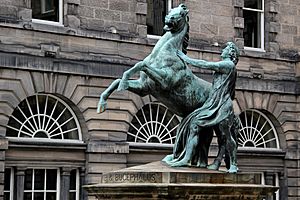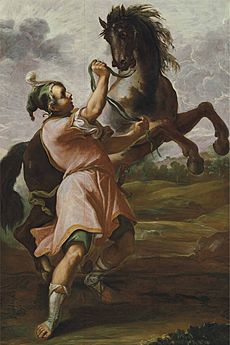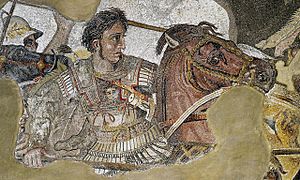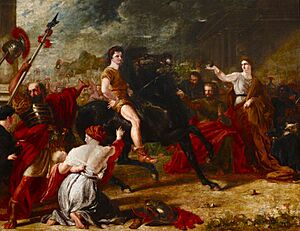Bucephalus facts for kids
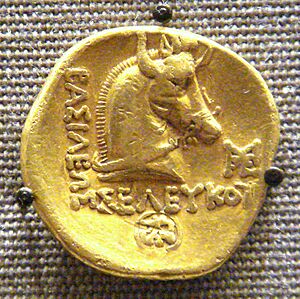
Coin depicting Bucephalas, issued by Seleucus I Nicator. Note the horns on his head, from a literal interpretation of his name, which means "ox-head".
|
|
| Species | Horse |
|---|---|
| Sex | Male |
| Born | c. 355 BC |
| Died | June 326 BC (aged 30) Pentapotamia, Macedonian Empire (modern-day Pakistan) |
| Resting place | Bucephala |
| Occupation | Warhorse |
| Years active | 344 BC – 326 BC |
| Owner | Alexander III of Macedon |
Bucephalus (pronounced Boo-SEF-uh-lus) was the legendary horse of Alexander the Great. He is one of the most famous horses from ancient times. His name means "ox-headed" in ancient Greek. Some stories say this came from a mark on his thigh that looked like an ox's head. Bucephalus was known for being a strong horse from the region of Thessaly. He lived from about 355 BC until June 326 BC. Bucephalus died in what is now Pakistan, after a big battle. Alexander was very sad to lose his horse. He even named a city, Alexandria Bucephalus, in his honor.
Contents
Taming the Wild Bucephalus
Bucephalus was a very large horse with a big head. He had a shiny black coat and a large white star on his forehead. Some stories say he also had a "wall eye," which means a blue eye. He came from the best horse breeds in Thessaly, a region in ancient Greece.
Alexander's Clever Wager
In 344 BC, when Alexander was just 12 or 13 years old, a horse dealer offered Bucephalus to Alexander's father, King Philip II. The horse was incredibly expensive, costing 13 talents. But no one could tame the wild horse. King Philip wasn't interested in buying him.
Young Alexander, however, was fascinated. He told his father he would pay for the horse himself if he failed to tame it. King Philip agreed to give his son a chance.
How Alexander Tamed the Horse
Alexander surprised everyone. He spoke calmly to Bucephalus. He noticed the horse was scared of its own shadow. So, Alexander gently turned the horse's head towards the sun. This way, Bucephalus could no longer see his shadow. Alexander also dropped his flowing cloak, which might have been startling the horse.
With these clever actions, Alexander successfully tamed the powerful horse. Plutarch, an ancient writer, said King Philip was so impressed. He told Alexander, "My son, you need to find a kingdom big enough for you, because Macedonia is too small!"
Mythical Origins of Bucephalus
Some legends, like the Alexander Romance, tell a more magical story about Bucephalus. In these tales, Bucephalus was an extraordinary colt, even more amazing than the winged horse Pegasus. He was born on King Philip's own lands. An ancient prophecy from the Delphic Oracle said that the future king of the world would be the one who could ride Bucephalus. This special horse had the mark of an ox's head on his side.
Alexander and His Loyal Warhorse
Bucephalus was more than just a horse; he was Alexander the Great's trusted companion. He carried Alexander through many important battles. Their bond was legendary.
A Hero's Horse
Alexander valued Bucephalus greatly. He was inspired by the hero Achilles from Greek myths. Achilles believed his horses were special and even immortal. Alexander felt a similar deep connection to Bucephalus.
The End of a Legend
Historians have different ideas about how Bucephalus died. Some, like Arrian, say he lived to be about 30 years old. They suggest he died of old age or exhaustion. However, other accounts say Bucephalus suffered fatal injuries during the fierce Battle of the Hydaspes in June 326 BC. In this battle, Alexander's army defeated King Porus.
Alexander was heartbroken by the loss of his beloved horse. To honor Bucephalus, he immediately founded a city named Bucephala. This city was located on the west bank of the Hydaspes River, which is now the Jhelum in modern-day Pakistan. Some people believe the town of Jalalpur Sharif is where Bucephalus was buried.
Growing Legends
The story of Bucephalus became even more famous alongside Alexander's own legend. Some tales even claimed that Alexander and Bucephalus were born at the same time. Later versions of the Alexander Romance also suggested they died at the same hour. Bucephalus appears in many ancient stories and artworks about Alexander.
See also
 In Spanish: Bucéfalo para niños
In Spanish: Bucéfalo para niños
- List of historical horses
- List of fictional horses


